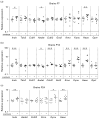Neonatal infection with neurotropic influenza A virus induces the kynurenine pathway in early life and disrupts sensorimotor gating in adult Tap1-/- mice
- PMID: 19607757
- PMCID: PMC2857580
- DOI: 10.1017/S1461145709990253
Neonatal infection with neurotropic influenza A virus induces the kynurenine pathway in early life and disrupts sensorimotor gating in adult Tap1-/- mice
Abstract
Epidemiological studies suggest that early life infections may contribute to the development of neuropsychiatric disorders later in life. Experimental studies employing infections during neonatal life support this notion by reporting persistent changes in the behaviour of adult animals, including deficits in sensorimotor gating. We have previously described an induction of the kynurenine pathway in neonatal wild-type (WT) mice following a systemic infection with neurotropic influenza A/WSN/33 virus. Here, we use the same model of infection in both WT and Tap1-/- mice (expressing reduced levels of MHC class I) and study long-term effects of the infection on sensorimotor gating, as determined by measuring prepulse inhibition (PPI). Moreover, transcription of genes encoding enzymes in the kynurenine pathway and levels of kynurenic acid (KYNA), in the brain of Tap1-/- mice were investigated. In mice infected on postnatal day (P)3 or P4, the levels of several transcripts in the kynurenine pathway were altered at P7, P13 and P24. Transcripts encoding indoleamine-pyrrole 2,3-dioxygenase (IDO), degrading tryptophan in the first step of the kynurenine pathway were consistently up-regulated at all time-points investigated. The changes in transcript levels were accompanied by a transient elevation of KYNA in the brain of infected mice at P13. At age 5-6 months, neonatally infected Tap1-/-, but not WT, mice exhibited a reduction in PPI. The present data show that a neonatal infection targeting the brain can induce the kynurenine pathway and that such an infection can disrupt sensorimotor gating in adulthood in genetically vulnerable mice.
Conflict of interest statement
Figures





Similar articles
-
Behavioral disturbances in adult mice following neonatal virus infection or kynurenine treatment--role of brain kynurenic acid.Brain Behav Immun. 2014 Feb;36:80-9. doi: 10.1016/j.bbi.2013.10.010. Epub 2013 Oct 17. Brain Behav Immun. 2014. PMID: 24140727 Free PMC article.
-
Induction of the kynurenine pathway by neurotropic influenza A virus infection.J Neurosci Res. 2008 Dec;86(16):3674-83. doi: 10.1002/jnr.21799. J Neurosci Res. 2008. PMID: 18655201
-
Neonatal infection with neurotropic influenza A virus affects working memory and expression of type III Nrg1 in adult mice.Brain Behav Immun. 2009 Aug;23(6):733-41. doi: 10.1016/j.bbi.2009.04.004. Epub 2009 Apr 10. Brain Behav Immun. 2009. PMID: 19362585
-
Neurobiological mechanisms in the kynurenine pathway and major depressive disorder.Rev Neurosci. 2024 Sep 9;36(2):169-187. doi: 10.1515/revneuro-2024-0065. Print 2025 Feb 25. Rev Neurosci. 2024. PMID: 39245854 Review.
-
Indoleamine 2,3-dioxygenase-2; a new enzyme in the kynurenine pathway.Int J Biochem Cell Biol. 2009 Mar;41(3):467-71. doi: 10.1016/j.biocel.2008.01.005. Epub 2008 Jan 11. Int J Biochem Cell Biol. 2009. PMID: 18282734 Review.
Cited by
-
Inflammation and the two-hit hypothesis of schizophrenia.Neurosci Biobehav Rev. 2014 Jan;38:72-93. doi: 10.1016/j.neubiorev.2013.11.006. Epub 2013 Nov 15. Neurosci Biobehav Rev. 2014. PMID: 24247023 Free PMC article. Review.
-
Assessment of Prenatal Kynurenine Metabolism Using Tissue Slices: Focus on the Neosynthesis of Kynurenic Acid in Mice.Dev Neurosci. 2019;41(1-2):102-111. doi: 10.1159/000499736. Epub 2019 May 22. Dev Neurosci. 2019. PMID: 31117076 Free PMC article.
-
Central Nervous System Infection with Borna Disease Virus Causes Kynurenine Pathway Dysregulation and Neurotoxic Quinolinic Acid Production.J Virol. 2017 Jun 26;91(14):e00673-17. doi: 10.1128/JVI.00673-17. Print 2017 Jul 15. J Virol. 2017. PMID: 28446679 Free PMC article.
-
Pre- and postnatal exposure to kynurenine causes cognitive deficits in adulthood.Eur J Neurosci. 2012 May;35(10):1605-12. doi: 10.1111/j.1460-9568.2012.08064.x. Epub 2012 Apr 20. Eur J Neurosci. 2012. PMID: 22515201 Free PMC article.
-
Antipurinergic therapy corrects the autism-like features in the Fragile X (Fmr1 knockout) mouse model.Mol Autism. 2015 Jan 13;6:1. doi: 10.1186/2040-2392-6-1. eCollection 2015. Mol Autism. 2015. PMID: 25705365 Free PMC article.
References
-
- Adams O, Besken K, Oberdorfer C, MacKenzie CR, et al. Inhibition of human herpes simplex virus type 2 by interferon gamma and tumor necrosis factor alpha is mediated by indoleamine 2,3-dioxygenase. Microbes and Infection. 2004a;6:806–812. - PubMed
-
- Alberati-Giani D, Ricciardi-Castagnoli P, Kohler C, Cesura AM. Regulation of the kynurenine metabolic pathway by interferon-gamma in murine cloned macrophages and microglial cells. Journal of Neurochemistry. 1996;66:996–1004. - PubMed
-
- Asp L, Nellaker C, Karlsson H. Influenza A virus transactivates the mouse envelope gene encoding syncytin B and its regulator, glial cells missing 1. Journal of Neurovirology. 2007;13:29–37. - PubMed
Publication types
MeSH terms
Substances
Grants and funding
LinkOut - more resources
Full Text Sources
Research Materials

